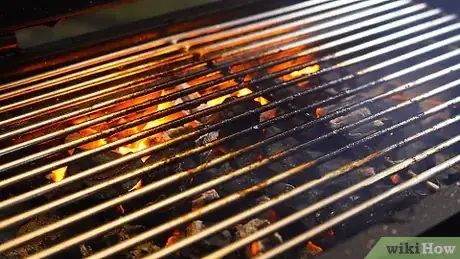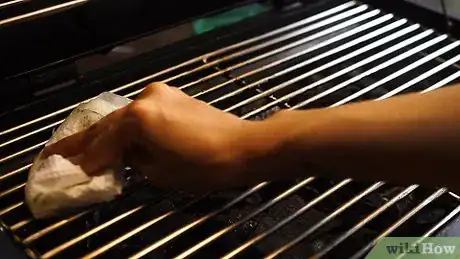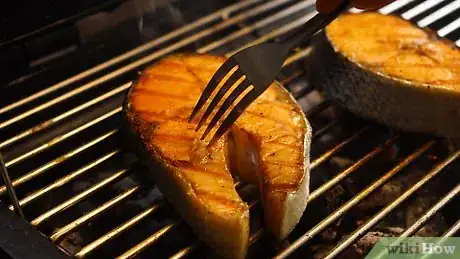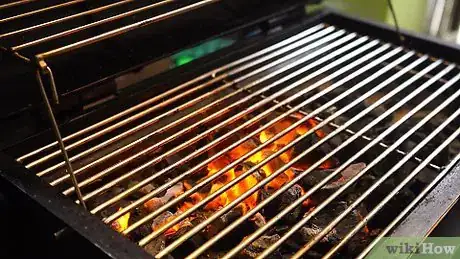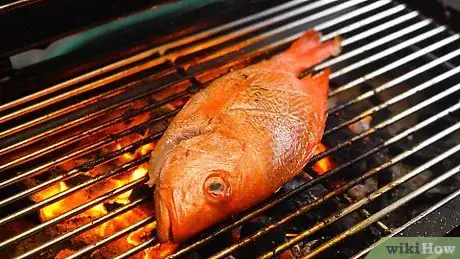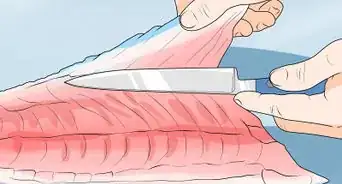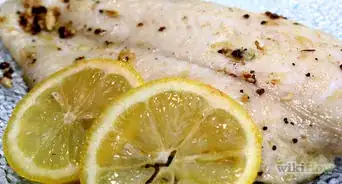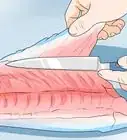This article was co-authored by Ollie George Cigliano and by wikiHow staff writer, Megaera Lorenz, PhD. Ollie George Cigliano is a Private Chef, Food Educator, and Owner of Ollie George Cooks, based in Long Beach, California. With over 20 years of experience, she specializes in utilizing fresh, fun ingredients and mixing traditional and innovative cooking techniques. Ollie George holds a BA in Comparative Literature from The University of California, Berkeley, and a Nutrition and Healthy Living Certificate from eCornell University.
There are 19 references cited in this article, which can be found at the bottom of the page.
This article has been viewed 355,724 times.
Grilled fish is a healthy and tasty dish that you can cook up in a matter of minutes. If you choose a thick and sturdy fish, you won’t need foil, a grilling basket, or any other special tools. With minimal prepping and seasoning necessary, you'll be a pro in no time! You can either cook fish fillets or grill up a whole fish. Before you start, clean your grill grate thoroughly and oil it to keep your fish from sticking.
Steps
Cleaning the Grill to Prevent Sticking
-
1Turn the grill on to about 550 °F (288 °C) to burn off grime. Cover the grate on your grill with a layer of aluminum foil. Turn your grill up to a high-heat setting if you’re using a gas grill, or open the dampers completely to let in oxygen if you’re using a charcoal grill. Let the grill sit with the heat on for 10-15 minutes to loosen up cooked-on grime and grease. This will help prevent the fish from sticking to the grill once you start to cook.[1]
- Cover the grill with the lid to keep heat from escaping. If it’s a charcoal grill, leave the vents open to feed the fire with oxygen.
-
2Soak the grill grate for 30 minutes in warm, soapy water. Turn off the grill and give it 20-30 minutes to cool down. Once the grate is cool, remove it from the grill and put it in a tub of warm water and dish soap. Let it soak for about half an hour to help loosen any stuck-on, carbonized gunk.[2]
- If there are any big chunks of debris sticking to the grate, loosen them up before you put the grate in the bucket by giving the grate a quick scrub with a soapy wire brush.
Advertisement -
3Scrub the grate with a wire grill brush to remove stubborn dirt. Once the residue on the grill grate has softened a bit in the water, dip a wire brush in the bucket and then firmly scrub the grate with it.[3] Dump out the dirty water and rinse the grate thoroughly when you’re done.
- If there’s still any grease or dirt on the grate, go over it again with a soapy kitchen sponge. You can also try scrubbing the stubborn spots with a baking soda and vinegar paste.[4]
- The cleaner your grill, the less likely it is that fish will stick to it.
-
4Wipe the grate with oil to prevent sticking. Dip a paper towel in a little vegetable oil and wipe down the bars of the grate with it. Keep wiping the bars until they have a nice, glossy sheen.[5]
- Depending on how big your grill grate is, you might have to go over it a few times. However, don’t overdo it. If your grill grate is dripping with oil, it could cause a flareup when you light the fire.[6]
Fillets
-
1Choose a thick and sturdy fillet, like tuna or salmon steak. You can cook most types of fish on a grill, but some will hold up better than others. If you want to cook your fish directly on the grill, avoid thin and delicate types of fish, like flounder or sole. Stick to thicker cuts of tougher fish, such as halibut, haddock, salmon, tuna, swordfish, or mahi-mahi.[7]
- If you’d rather cook a more delicate fillet, wrap it in aluminum foil or put it in a grilling basket to prevent the meat from falling through the grill grate. You can also set the fillets on top of a bed of lemon slices instead of directly on the grill.[8]
-
2Slice your fillets into the desired number of portions. If you’re planning to feed multiple people, portion your fish while it’s still raw to keep it from falling apart. Lay the fillets skin-side down on a clean cutting board and cut through them crosswise with a sharp kitchen knife. If your fillets are skinless, lay the side that used to have skin on it face-down.[9]
- Slicing up your fillets into smaller pieces will also make them easier to manage on the grill. It’s much harder to flip a huge piece of fish.
- Cut pieces from the thinner, tail end of the fish a little larger than the thicker middle pieces. That way, you can distribute the meat more evenly when it’s time to serve the fish.
-
3Season the fish with oil, salt, and pepper for extra flavor. Drizzle your fish with a little olive oil to lock in moisture and make it less likely to stick. You can also sprinkle on some salt and pepper to taste, or even add a splash of lemon juice or balsamic vinegar.[10]
- Some chefs don’t recommend marinating grilled fish, since it makes the fish more likely to fall apart. If you want to use a marinade, soak the fish for no longer than 30 minutes to prevent the tissues from breaking down.[11]
-
4Place the fish on the grill with the skin side down. When the grill is hot, lay your seasoned fillets on it diagonally. Make sure the side that has skin, or used to have skin, is facing down. Orienting the fish diagonally will create beautiful grill marks and make the fish easier to turn.[12]
-
5Reduce the heat to medium, cover the grill, and let the fish cook. If you’re using a gas grill, set the heat to about 350 °F (177 °C). For a charcoal grill, leave the dampers half-open to get the temperature in the right range. Cover the grill and wait 3-4 minutes before checking on the fish. Resist the urge to mess with it before then, or your fillets could fall apart.[13]
- When you think your fish might be ready to turn, slide a thin spatula under 1 corner and lift it up for a quick peek. If the fish is ready to flip, it should lift off the grate easily and appear opaque and slightly seared on the side touching the grill.[14]
- If the fish doesn’t seem ready, give it another 20 seconds before checking again.
- If you’re cooking a tuna steak and want to leave the center rare, leave the grill open. Closing the hood helps the fish cook all the way through.
-
6Flip the fish carefully with a thin, wide spatula. Once the fish looks ready to turn, slip a fine-edged metal spatula underneath it. If the piece of fish is big, give it a little extra support by holding the top of the fillet in place with a second spatula or flexible fish turner.[15]
- Don’t try to turn the fish if it’s stubbornly sticking to the grill. Wait another 1-2 minutes and try again.
-
7Cover the grill for another 3-4 minutes, then check for doneness. Give the fish a few more minutes to cook through, then take a fork and gently try to flake some of the meat. As soon as the meat begins to flake, take the fish off the grill. It will continue to cook through as it rests.[16]
- The USDA recommends cooking fish until it reaches an internal temperature of 145 °F (63 °C). If you have a meat thermometer, insert it into the thickest part of the fillet to test the temperature.
- In general, it takes about 8 minutes per 1 inch (2.5 cm) of thickness for a fish fillet to cook through completely.
Whole Fish
-
1Buy a fresh, whole fish from your grocery store or local meat market. Choose a fish that looks and smells fresh. Check for eyes that look shiny and clear, firm skin and flesh, and a mild odor. The gills should be nice and red.[17]
- Skip any fish that are mushy, discolored, or have a strong, unpleasant smell. These are signs that the fish has started to go bad.
- Many fish from the market are already precleaned, scaled, and gutted. However, this isn’t always the case. If the fish isn’t already cleaned, ask the butcher to do it for you or do it yourself at home.[18]
- In some ways, whole fish are easier to cook than fillets. They’re harder to overcook and easier to check for doneness. Plus, the bones and skin add extra flavor and moisture.
-
2Score the fish’s skin with a sharp knife. Take a sharp kitchen knife and cut a series of deep slits into the fish’s skin on both sides, cutting at a 45° angle. Make the slits deep enough to reach the bone, and space them out around 1 to 2 inches (2.5 to 5.1 cm) apart. This will help the fish cook more evenly.[19]
- Use a well-sharpened chef’s knife, since a dull knife might tear up or mangle the meat.
-
3Season the fish’s inside cavity with salt and pepper. Add salt and black pepper to the inner cavity of the fish to taste. This will give you a juicy and flavorful result. If your fish is big enough, you can also stuff it with tasty herbs, aromatics, or citrus slices.[20]
- For example, you could stuff your fish with garlic and butter, rosemary, lemon slices, green onions, or basil.
- As a more complex alternative to salt and pepper, coat the inner cavity with a seafood rub.
-
4Coat the fish with oil to keep it from sticking to the grill. Brush a light coating of olive or vegetable oil onto the outside of your fish to lock in moisture and prevent sticking. Use about 1 tablespoon (15 mL) of oil.[21]
- As an alternative to oil, try another fat-rich coating, like mayonnaise. If you don’t like mayo, don’t worry—the distinctive mayo flavor will cook away, leaving you with a moist, delicious fish.
- Sprinkle a little salt and pepper on the outside of the fish to add more flavor.
-
5Heat the grill to medium-high heat before adding the fish. Turn your grill up to high if it’s a gas grill, or open the vents if it’s a charcoal grill. Get your grill nice and hot—around 400 °F (204 °C)—before adding the fish so that it will sear faster. This is a good way to prevent sticking.[22]
- To help the fish cook more evenly, consider using indirect heat. This involves setting the fish on an area of the grill that’s not directly over a heat source—for example, make a pile of coals under one side of the grate, then put the fish on the other side.[23]
-
6Let your fish cook for 3-4 minutes with the grill hood closed. Cover the grill and leave the fish alone for a few minutes. Resist the urge to check on the fish or try to turn them before 3-4 minutes have passed, since you could accidentally damage the fish.[24] After a few minutes have passed, slip a spatula under an edge of the fish and see if it lifts easily off the grill.
- If the fish lifts up easily, it’s ready to turn. If not, give it another 30 seconds to 1 minute, then check again.
- Most whole fish will take about 10 minutes per 1 inch (2.5 cm) of thickness to cook through completely. If you’re cooking a thick fish, you may need to wait longer (e.g., 5-7 minutes) before turning it over.
-
7Flip the fish once it comes off the grill easily. Take a wide, thin spatula and gently slide it under the fish. If the fish is ready to turn, it should release from the grill grate without a fight. Carefully flip the fish over onto the other side, then close the grill and let it cook for another few minutes.
- If you’re cooking a big fish, stabilize it by sliding 2 spatulas under it at once. You can also use a flexible fish turner to hold the top of the fish while you slide a metal spatula underneath it.
-
8Test the fish for doneness by flaking it with a fork. Gently insert a fork or the tip of a knife into the thickest part of the fish and see if it flakes. If the fish flakes easily and is just barely opaque, it’s time to take it off the grill.[25]
- Let the fish rest for about 5 minutes before you serve it. During the rest period, the fish will finish cooking and the juices will have time to spread through the flesh.
- You can also test the fish by holding the cavity open with a spatula and flaking the meat next to the backbone with a knife.
Community Q&A
-
QuestionWhat do I put on grill fish to keep it from drying out?
 Community AnswerOffset the fish from the heat and add a water tray on the heat. This will grill and steam the fish, whilst locking in the juices.
Community AnswerOffset the fish from the heat and add a water tray on the heat. This will grill and steam the fish, whilst locking in the juices. -
QuestionI have been reading a lot about various ways to prepare fish on the grill, but I haven't seen any of these that deal with cod loins. Are cod loins not a smart choice for fish to be grilled?
 Community AnswerYou can grill any fish, it just depends on how you prepare it. Go from practice and eventually you will learn how to cook it on a grill.
Community AnswerYou can grill any fish, it just depends on how you prepare it. Go from practice and eventually you will learn how to cook it on a grill. -
QuestionDo these steps work with bass or catfish?
 Community AnswerYes, they do.
Community AnswerYes, they do.
Warnings
- Try not to burn or overcook the fish. It does not take too long to cook, so watch it closely. Fish gets tough when it’s overcooked.⧼thumbs_response⧽
Things You’ll Need
- Wire grill brush
- Dish soap
- Large tub or bucket
- Kitchen sponge
- Paper towels
- Vegetable oil
- Sharp kitchen knife
- Thin spatula
- Meat thermometer
References
- ↑ https://www.delish.com/cooking/g2175/how-to-grill-fish-on-a-gas-grill/?slide=4
- ↑ https://www.popularmechanics.com/home/food-drink/how-to/a26737/how-to-clean-bbq-grill/
- ↑ https://www.delish.com/cooking/g2175/how-to-grill-fish-on-a-gas-grill/?slide=5
- ↑ https://www.popularmechanics.com/home/food-drink/how-to/a26737/how-to-clean-bbq-grill/
- ↑ https://www.delish.com/cooking/g2175/how-to-grill-fish-on-a-gas-grill/?slide=5
- ↑ https://www.seriouseats.com/2010/04/how-to-clean-your-grill-barbecue-oiling-thegrate-charcoal.html
- ↑ http://www.seriouseats.com/2012/07/how-to-grill-fish.html
- ↑ https://www.freep.com/story/life/food/recipes/2015/08/20/cirtrus-grilled-salmon/32076711/
- ↑ https://www.myrecipes.com/how-to/how-to-skin-and-portion-fish
- ↑ https://www.today.com/food/grill-fish-pro-these-tips-barbecue-master-t22476
- ↑ https://www.epicurious.com/recipes/food/views/grilled-fish-51159800
- ↑ https://www.delish.com/cooking/g2175/how-to-grill-fish-on-a-gas-grill/?slide=6
- ↑ https://www.delish.com/cooking/g2175/how-to-grill-fish-on-a-gas-grill/?slide=7
- ↑ https://www.delish.com/cooking/g2175/how-to-grill-fish-on-a-gas-grill/?slide=7
- ↑ https://www.seriouseats.com/2012/07/how-to-grill-fish.html
- ↑ https://www.today.com/food/grill-fish-pro-these-tips-barbecue-master-t22476
- ↑ https://www.fda.gov/food/buy-store-serve-safe-food/selecting-and-serving-fresh-and-frozen-seafood-safely
- ↑ https://ncseagrant.ncsu.edu/mariners-menu/2011/08/market-forms-of-fresh-fish-and-cleaning-methods/
- ↑ https://www.bonappetit.com/test-kitchen/inside-our-kitchen/article/how-to-grill-a-whole-fish-step-by-step
- ↑ https://www.chicagotribune.com/dining/recipes/sc-grilled-fish-brownson-food-0520-20160518-column.html
- ↑ https://www.bonappetit.com/test-kitchen/inside-our-kitchen/article/how-to-grill-a-whole-fish-step-by-step
- ↑ https://share.upmc.com/2014/05/forget-burgers-fish-summer/
- ↑ https://www.recipetips.com/kitchen-tips/t--1231/fish-cooking-guide.asp#grillsalmon
- ↑ https://www.bonappetit.com/test-kitchen/inside-our-kitchen/article/how-to-grill-a-whole-fish-step-by-step
- ↑ https://www.recipetips.com/kitchen-tips/t--1231/fish-cooking-guide.asp#grillsalmon
About This Article
To grill fish, start by cutting it up into small fillets so it's easier to cook. Then, season or marinate the fillets while your grill is preheating to around 550 degrees Fahrenheit. Once the grill is hot enough, place the fillets directly on the grill grate, reduce the heat to medium, and let them cook for 3-5 minutes. Next, flip the fillets over and let them cook for 3-5 minutes on the other side. Finally, take the fillets off the grill once they're firm and opaque all the way through. To learn how to grill a whole fish, scroll down!
